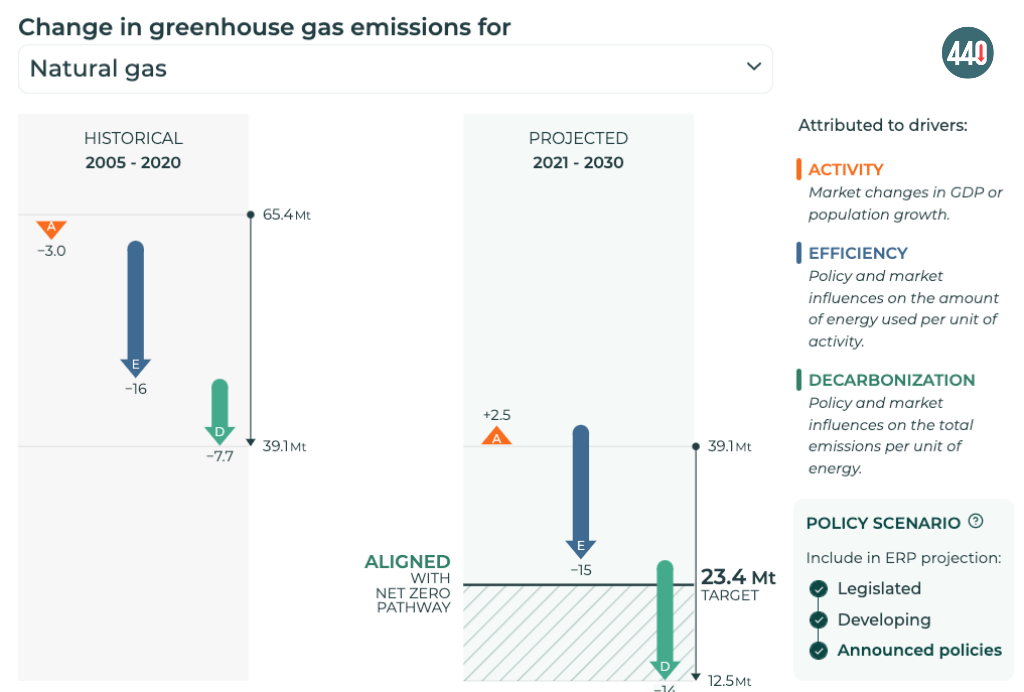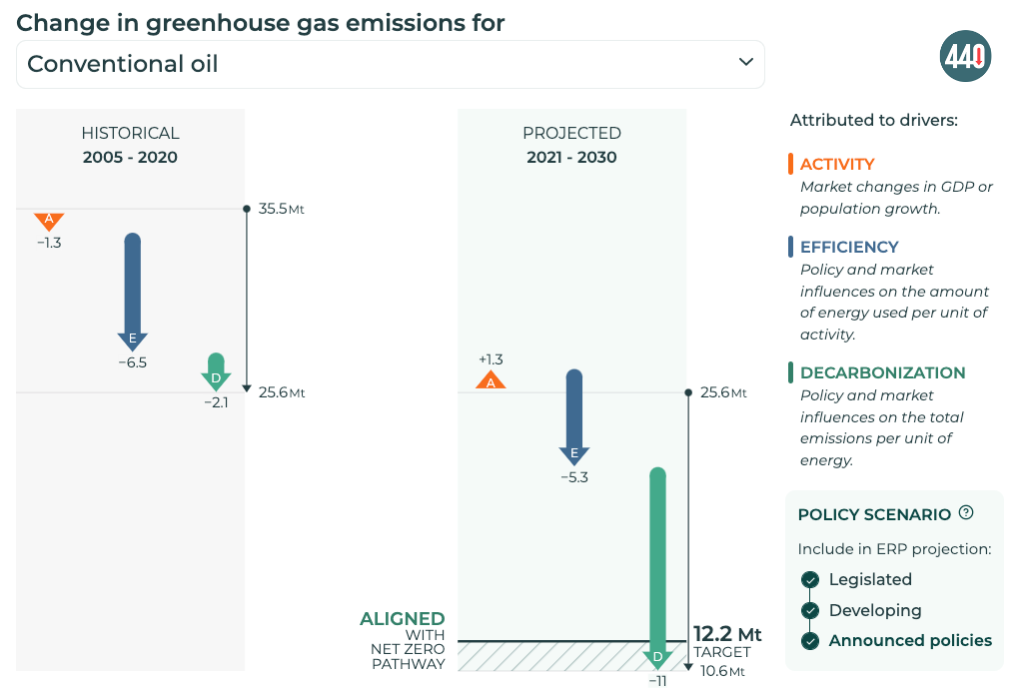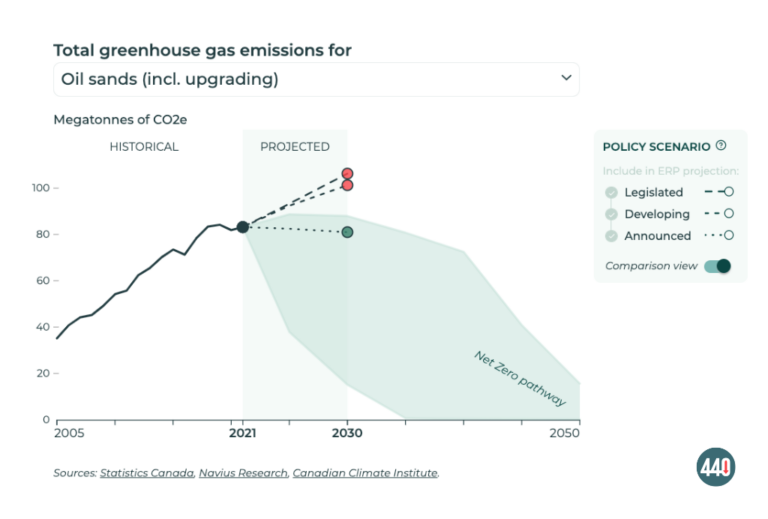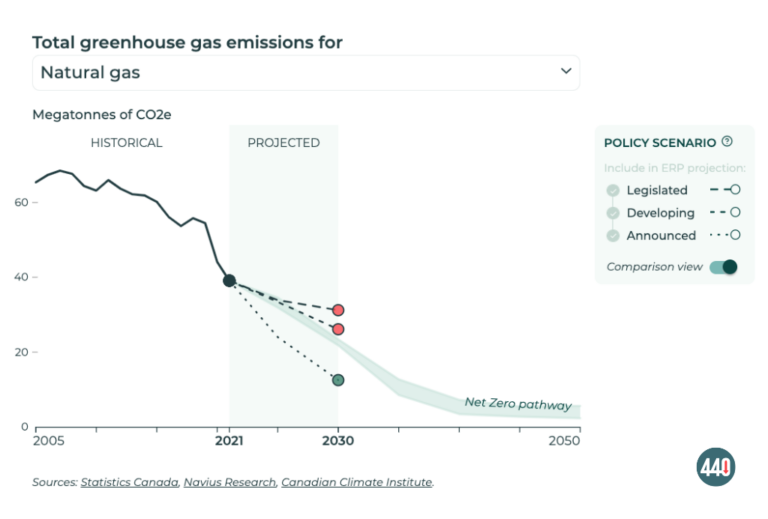Hitting Canada’s 2030 climate targets hinges on the rapid and effective implementation of new policy that cuts emissions across the entire oil and gas sector.
What’s new?
The upstream oil and gas sector—comprising oil sands, conventional oil, and natural gas production—needs to dramatically reduce emissions if Canada is to limit greenhouse gas emissions to 440 megatonnes by 2030.
Unfortunately, our analysis indicates that existing policies are not enough to contain the projected growth in oil and gas emissions this decade. Further policy action—such as successfully implementing an oil and gas emissions cap and tighter methane controls— will be essential to making the deep and rapid emission reductions required to bring this sector in line with Canada’s 2030 target.
Figure 1: Further policy action is needed to align oil sands emissions with a net zero pathway
The details
You can see the scale of emissions reductions required under various policy scenarios using 440 Megatonnes’ new interactive Pathways Tracker. This tool is based on the Canadian Climate Institute’s Independent Assessment of the federal Emissions Reduction Plan (ERP).
The tracker provides detailed emissions projections for 10 sectors, as well as Canada’s economy as a whole. Exploring the data on emissions from the upstream oil and gas sector, for example, presents two important insights:
- Legislated policies that have already been implemented are not sufficient to address rising emissions in the oil and gas sector. In our simulations, 2030 emissions from the sector are 6 per cent above 2021 levels and 15 per cent above 2005 levels under the legislated policies scenario.
- Additional measures will be required to contain the projected growth in oil and gas emissions this decade. Announced and developing policies included in Canada’s Emissions Reduction Plan will need to reduce emissions from the sector by more than 44 megatonnes by 2030—30 per cent below 2021 levels—to meet the objectives in Canada’s Emissions Reduction Plan.
Figure 2: Existing policy puts natural gas within striking distance of a net zero pathway
Why it matters
Additional policy will undoubtedly be needed to contain the projected 20 Mt rise in oil sands emissions anticipated this decade—our projections see just 1 per cent of national reductions coming from the oil sands by 2030.
In the short term, however, big emission-reduction wins could come from ramping up carbon policy and energy efficiency in natural gas and conventional oil, which could deliver 12 per cent and 7 per cent, respectively, of Canada’s overall emission reductions by 2030.
Here’s what the Pathways Tracker shows:
- Natural gas: Between 2005 and 2020 the natural gas sector decreased its emissions by just over 26 Mt. Based on announced policies, we anticipate little emissions growth from expanded output, while policy- and market-driven energy efficiency improvements and decarbonization deliver significant reductions, leading to a net drop of 27 Mt by 2030.
Figure 3: Natural gas presents big energy efficiency and abatement opportunities

- Conventional oil: Production remained more or less flat between 2005 and 2020, while energy efficiency and some carbon policy reduced emissions by a total of 10 Mt. Looking forward, very little emissions growth from output is expected under the announced-policies scenario, whereas energy efficiency gains and decarbonization will significantly reduce emissions, resulting in a net drop of 15 Mt by 2030.
Figure 4: Conventional oil could contribute significant emissions reductions

Dave Sawyer is the Principal Economist for the Canadian Climate Institute. Brad Griffin is the Executive Director of the Canadian Energy and Emissions Data Centre at Simon Fraser University and an advisor to the 440 Megatonnes project.


